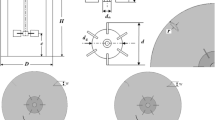Abstract
The master equation of the Francis turbine is derived based on the combination of the angular momentum (Euler) and the energy laws. It relates the geometrical design of the impeller and the regulation settings (guide vane angle and rotational speed) to the discharge and the power output. The master equation, thus, enables the complete characteristics of a given Francis turbine to be easily computed. While applying the energy law, both the shock loss at the impeller inlet and the swirling loss at the impeller exit are taken into account. These are main losses which occur at both the partial load and the overloads and, thus, dominantly influence the characteristics of the Francis turbine. They also totally govern the discharge of the water through the impeller when the impeller is found in the standstill. The computations have been performed for the discharge, the hydraulic torque and the hydraulic efficiency. They were also compared with the available measurements on a model turbine. Excellent agreement has been achieved. The computations also enable the runaway speed of the Francis turbine and the related discharge to be determined as a function of the setting angle of the guide vanes.
Similar content being viewed by others
References
Drtina P., Sallaberger M. Hydraulic turbines–basic prin-ciples and state-of-the-art computational fluid dynamics applications [J]. Proceedings of the Institution of Mechanical Engineers Part C Journal of Mechanical Engineering Science, 1999, 213(1): 85–102.
Zeng W., Yang J., Cheng Y. Construction of pump-turbine characteristics at any specific speed by domain-partitioned transformation [J]. Journal of Fluids Engineering, 2015, 137(3): 031103.
Zeng W., Yang J. D., Cheng Y. G. et al. Formulae for the intersecting curves of pump-turbine characteristic curves with coordinate planes in three-dimensional parameter space [J]. Proceedings of the Institution of Mechanical Engineers Part A Journal of Power and Energy, 2015, 229(3): 324–336.
Zhang Zh., Titzschkau M. Self-validated calculation of characteristics of a Francis turbine and the mechanism of the S-shape operational instability [J]. IOP Conference Series: Earth and Environmental Science, 2012, 15(3): 032036
Zhang Zh. Streamline similarity method for flow distribu-tions and shock losses at the impeller inlet of the centrifugal pump [J]. Journal of Hydrodynamics, 2018, 30(1): 140–152
Hasmatuchi V., Roth S., Botero F. et al. High-speed flow visualization in a pump-turbine under off-design operating conditions [C]. 25th IAHR Symposium on Hydraulic Machinery and Systems, Timisoara, Romania, 2010.
Staubli T., Senn F., Sallaberger S. Instability of pump-turbines during start-up in turbine mode [C]. Hydro 2008, Ljubljana, Slovenia, 2008.
Martinm C. Instability of pump-turbines with S-shaped characteristics [C]. 20th IAHR Symposium on Hydraulic Machinery and Systems, Charlotte, USA, 2000.
Zuo Z., Fan H., Liu S. et al. S-shaped characteristics on the performance curves of pump-turbines in turbine mode–A review [J]. Renewable and Sustainable Energy Reviews, 2016, 60: 836–851.
Sun H., Xiao R., Liu W. et al. Analysis of S characteristics and pressure pulsations in a pump-turbine with misaligned guide vanes [J]. Journal of Fluids Engineering, 2013, 135(5): 511011.
Cavazzini G., Covi A., Pavesi G. et al. Analysis of the unstable behavior of a pump-turbine in turbine mode: Fluid-dynamical and spectral characterization of the S-shape characteristic [J]. Journal of Fluids Engineering, 2016, 138(2): 021105.
Merino J. M., Lopez A. ABB Varspeed generator boosts efficiency and operating flexibility of hydropower plant [J]. Fuel and Energy Abstracts, 1996, 37(4): 272.
Terens L., Schäfer R. Variable speed in hydropower generation utilizing static frequency converters [C]. Pro-ceedings of the International Conference on Hydropower, Nashville, Tennessee, 1993, 1860–1869.
Käling B., Schütte T. Adjustable speed for hydropower applications [C]. ASME Joint International Power Gene-ration Conference, Phoenix, Arizona, 1994.
Susan-Resiga R., Ciocan G., Anton I. et al. Analysis of the swirling flow downstream a Francis turbine runner [J]. Journal of Fluids Engineering, 2006, 128(1): 177–189.
Nielsen T. K., Olimstad G. Dynamic behaviour of rever-sible pump-turbines in turbine mode of operation [C]. The 13th International Symposium on Transport Phenomena and Dynamics of Rotating Machinery, Honolulu, USA, 2010.
ESHA. Guide on how to develop a small hydropower plant [R]. European Small Hydropower Association (ESHA), 2004.
Author information
Authors and Affiliations
Corresponding author
Additional information
Biography: Zh. Zhang (1957-), Male, Ph. D.
Rights and permissions
About this article
Cite this article
Zhang, Z. Master equation and runaway speed of the Francis turbine. J Hydrodyn 30, 203–217 (2018). https://doi.org/10.1007/s42241-018-0026-5
Received:
Accepted:
Published:
Issue Date:
DOI: https://doi.org/10.1007/s42241-018-0026-5




